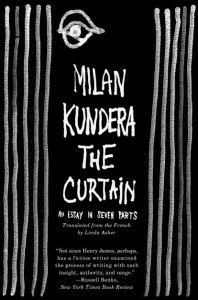Fuse Book Review: The Poetics of Surprise
Since it is the innovators who make up the real history of the novel, Milan Kundera muses on the increasing tenuousness of this tradition of eccentric innovation. He also charts how the new arises from a collision between forgetting and remembering images of the past.
The Curtain: An Essay in Seven Parts. By Milan Kundera. Translated from the French by Linda Asher. (Harper Collins, 168 pages, $22.95)
By Bill Marx
“Art is the sun, moon, and stars of the mind, the whole mind.” Samuel Beckett
The culture wars in America are only partly about winning ideological ground. Their real target is to curtail the free play of the imagination, an inventiveness that extends the alphabet of emotional and technical expression. Both the left and the right prefer art that teaches a lesson: conservatives accuse liberals of favoring fairy tales of liberation, while the left charges the right with advocating stories of moral rectitude. What poet William Wordsworth calls “the grand elementary principle of pleasure” is dismissed as amorality or capitalist fetish.
Pleasure desperately needs a champion amid the increasingly partisan squabbling. In addition, small-scale realism has exerted a stranglehold on American fiction over the past couple of decades, a healthy reaction, for some critics and writers, to the self-conscious authorial excesses of ‘60s postmodernism. More reason for a defense of the novel’s iconoclastic essence, its ability to range beyond the bonds of verisimilitude.
Acclaimed Czech novelist Milan (The Book of Laughter and Forgetting, The Unbearable Lightness of Being) Kundera is one of the most forceful advocates of the joys of the anarchistic imagination. In The Curtain, a slim but savory volume of criticism, the writer celebrates a “poetics of surprise; or beauty as perpetual astonishment.” For Kundera, the novel should challenge the uniformity of preconceived ideas, the smog of everyday existence that forms a reassuringly smothering curtain between us and the startling wildness of the world. He has argued this point more elaborately in two other volumes of criticism, The Art of the Novel and Testaments Betrayed. For those frustrated that The Curtain expresses its arguments via an impressionistic short hand, these earlier books should be consulted.
Kundera draws clear battle lines: when artists don’t search out the new and wallow in repetition, they aid and abet uniformity. Instead of using art to proclaim a position (political, philosophical, religious), writers should use it to investigate and understand overlooked dimensions of reality. Early novelists, Rabelais, Cervantes, and Henry Fielding among them, could experiment with ease. The parameters of what a novel was supposed to be had yet to be set. These writers “wanted to dazzle audiences by the enchantment of their storytelling rather than by the accuracy of their illusion of reality.” Why did that change? Over time expectations hardened and psychological realism arrived: “the novel’s magic came to lie in the visual and auditory evocation of scenes, plausibility became the supreme rule …”
Also, the notion of what was novel in the novel became problematic. An émigré from Eastern Europe who has lived in Paris since 1975, Kundera has an acute sense of how institutions and ideologies try to shape our perceptions of the new to their own ends: “Given an era’s political tendencies, a work of art necessarily ends up being classified as either progressive or reactionary; and since reaction is evil, the inquisition can start the trial proceedings.” In The Curtain, Kundera speaks in defense of the unruly, the surreal, and the transformative, for novels stuffed with essays, fables, authorial comments, and two-dimensional characters.
The Curtain looks, all-too-briefly, at some of Kundera’s favorite novels: Franz Kafka’s The Castle, Herman Broch’s The Sleepwalkers, and Witold Gombrowicz’s Ferdydurke. Had these books hewed to the plausible they wouldn’t reveal “previously unseen aspects of existence.” The art of the novel is an epistemological paradox: it is an enchanting game of fantasy that rigorously analyzes the world, a free-wheeling laboratory in which the writer’s imagination serves as a spry speculative tool. In this sense, the novelist is more of an antic scientist than a liberal humanist. Critics praised Salman Rushdie’s The Satanic Verses as an archetypal expression of liberalism. Kundera sees the novel as a “carnival of relativity,” filled with “the strange pleasure that comes of the certainty that there is no certainty.”
Since it is the innovators who make up the real history of the novel, Kundera muses on the increasing tenuousness of this tradition of eccentric innovation. He also charts how the new arises from a collision between forgetting and remembering images of the past. He wanders off into various interesting detours, such as whether old writers can still compose genuinely new work. The answer is an unsurprising yes.
Kundera is a bit too certain of himself in The Curtain. The informality of the essays, which include some amusing anecdotal interludes, beg questions and leaves the author open to the sniping of detractors. Just how inhuman or unreal can a novel be before it is no longer satisfying? The Curtain ends on an elegiac note, with Kundera fearing that the fiction he admires has no future. Granted, the novel is no longer at the center of Western culture, but that doesn’t mean it is doomed to do no more than “go docilely back into the service of the collective life that requires it to render repetition beautiful and help the individual merge, at peace and with joy, into the uniformity of being.” The darling of creative writing schools, domestic realism reigns now — but it will make way for more surprising in the future.
At the very least, The Curtain, along with Kundera’s other two books of criticism, will keep the ideal of originality alive, reminding readers and writers that plausibility is not enough. These days his vision of the novel as free play has the considerable virtue of allowing art — “the sun, moon, and stars of the mind”’ — to be an expanding universe.


